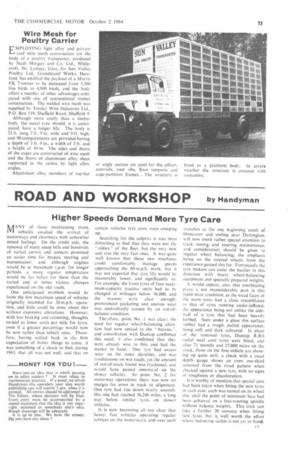ROAD AND WORKSHOP by Handyman
Page 75

If you've noticed an error in this article please click here to report it so we can fix it.
Higher Speeds Demand More Tyre Care
MANY of those maintaining trunk vehicles awaited the arrival of motorways and clearways with somewhat mixed feelings. On the credit side, the removal of many steep hills and hundreds of varied curves and corners promised an easier time for brakes, steering and transmission: and although engines would be at maximum r.p.m. for longer periods, a more regular temPerature would be far better for them than the varied and at times vicious changes experienced on the old roads, One anticipated problem would be from the low maximum speed of vehicles originally intended for 20 m.p.h. operation, and little could he done about this without expensive alterations. However, with less braking and cornering, thoughts turned to lower costs per mile for tyres, even if a greater percentage would now be new rather than rebuilt ones. Therefore, having settled hack in the firm expectation of better things to come, it was something of a shock to find, during 1963. that all was not well, and that on
__MONEY FOR YOU ?—
Have you an idea that is worth passing
on to other readers ? It must relate to maintenance practice. If a panel, on which Handyman sits, considers your idea worth publishing you will receive 3 gns. when it is printed. All entries should be addressed to The Editor, whose decision will be final. Every entry must be accompanied by a signed statement that the idea is not copyright, patented or somebody else's idea. Rough drawings will be adequate. It is up to you. We have the money. Do you have any ideas ? certain vehicles tyre costs were creeping up.
Searching for the culprits is was most disturbing to find that they were not the " oldies " of the fleet, but the very new and also the very fast ones. It was quite well known that these new mac:hines could comfortably manage speeds approaching the 60 m.p.h. mark. but it was not expected that tyre life would be measurably lower, and significantly so. For example, the front tyres of four maximum-capacity tractive units had to be changed at mileages below 36,000, and the reasons were clear enough: pronounced pocketing and uneven wear was undoubtedly caused by an out-ofbalance condition.
Therefore. point No. I was clear: the need for regular wheel-balancing attention had now spread to the " heavies ". and consultation with Dunlop confirmed this need; it also confirmed that they were already wise to this, and had the matter in hand. One tyre had excess wear on the outer shoulder, and was troublesome on wet roads, yet the amount of out-of-track found was fractional. and would have passed unnoticed on the slower vehicles, So point No. 2 for motorway operations: there was now no margin for error in track or alignment. One tyre had run down nearly smooth: this one had reached 36,246 miles, a long way below similar tyres on slower vehicles. It is now becoming all too clear that heavy, fast vehicles operating regular services on the motorways, and over such stretches as the one beginning south of Doncaster and ending near Darlington, vr ill now merit rather special attention to track setting and steering maintenance, and consideration should be given to regular wheel balancing, the emphasis being on the steered wheels from the experience gained this far. Fortunately the tyre makers can assist the haulier in this direction with heavy wheel-balancing equipment and specially prepared weights. It would appear. also, that overheating plays a not inconsiderable part in this rapid wear condition, as the tread faces of the worn tyres had a close resemblance to that of tyres running under-inflated, the appearance being not unlike the sidew all of a tyre that had been heavily kerbed. Seen under a glass this surface rubber had a rough, pulled. appearance, being soft and dark coloured. In place of the removed tyres, Dunlop R.B.6 radial steel cord lyres were fitted, and ifter 7-t months and 27.000 miles on the clock, those on the first vehicle are show ing up quite well; a check with a tread depth gauge shows an even one-third removed from the tread pattern when checked against a new tyre, with no signs of roughness or discoloration. It is worthy of mention that special care had been taken when fitting the new tyres ;n each case: each was turned on its wheel disc until the point of minimum bias had been achieved on a free-running spindle without balance weights, This trick can take a further 30 minutes when fitting new tyres. but is well worth the effort where balancing tackle is not yet to hand.






























































































































































































































